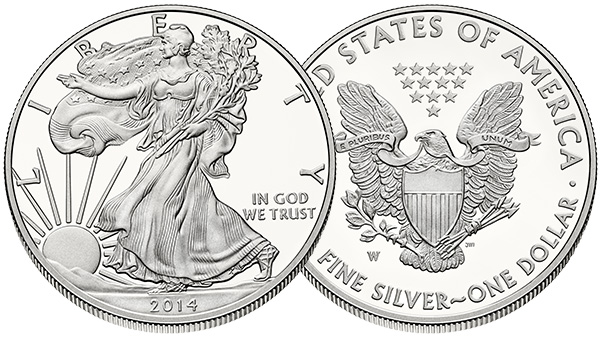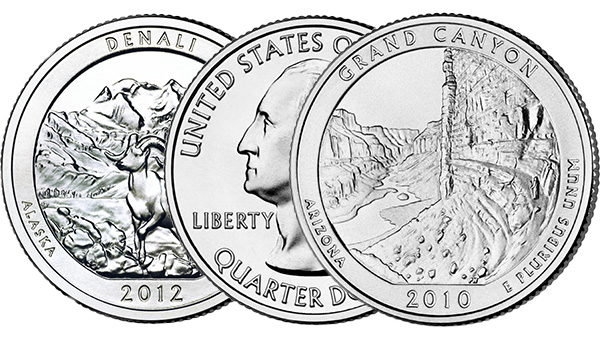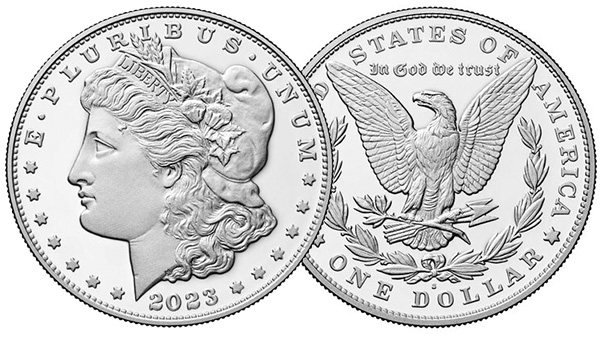Types of American Silver Coins
With their rich history and diverse designs, American silver coins have long been a staple in the portfolios of investors and collectors alike. These coins, minted by the United States Mint, come in a variety of types, each with its unique characteristics and values. This article will delve into the world of American silver coins, exploring the American Silver Eagle, the America the Beautiful series, historic silver dollars like the Morgan dollar and the Peace dollar, and the often overlooked 'junk' silver coins. Whether you're a seasoned collector, an investor looking to diversify, or a novice with an interest in numismatics, this comprehensive guide will provide valuable insights into these fascinating pieces of American history.
American Silver Eagle Coins

The allure of the American Silver Eagle coin is undeniable. Revered by investors and collectors alike, this coin is one of the purest silver coins ever produced by the U.S. Mint. Its blend of historical relevance and aesthetic appeal enhances its desirability. The coin's significant investment value is primarily due to its high silver content and the global recognition of its design. In the following sections, we will delve deeper into the design elements, historical importance, and investment potential of this silver coin. If you're intrigued by the world of silver coins, you won't want to miss this.
Definition, Design and Significance
The American Silver Eagle coin, introduced in 1986, is the United States' official silver bullion coin. Its popularity has soared over the years, making it one of the most sought-after bullion coins globally. The U.S. Mint is responsible for its production, and each coin contains one troy ounce of .999 pure silver, underscoring its status as a top-tier investment-grade coin.
The coin's obverse design is a tribute to the 'Walking Liberty', a creation of Adolph A. Weinman. It features Lady Liberty in full stride, draped in an American flag, with her right hand outstretched and branches of laurel and oak in her left. The reverse side, designed by John Mercanti, showcases an eagle beneath 13 small stars, symbolizing the original colonies.
The coin's value extends beyond its silver content. Its design elements carry historical and symbolic weight. Lady Liberty, a beacon of freedom and hope, and the majestic eagle, a representation of strength and independence, add to the coin's cultural and emotional value. As a product of the U.S. Mint, the Silver Eagle is backed by the U.S. Federal Government for its weight, content, and purity, making it a reliable and popular choice among investors and collectors.
Investment Value of American Silver Eagle Coins
The allure of American Silver Eagle coins extends beyond their stunning design and historical significance. Thanks to their pure silver content and the global recognition they enjoy, they are a prized asset for investors. As tangible assets, these coins offer a buffer against inflation and a safety net during financial downturns.
The .999 fine silver purity of these coins, coupled with the backing of the U.S. government, assures investors of their weight and purity. This assurance bolsters investor confidence, making these coins a reliable investment. The numismatic appeal of their design can potentially boost the market price of these coins beyond the value of their silver content. However, it's worth noting that the bullion versions of these rare coins usually mirror the silver price in commodity markets.
Potential tax benefits are an added advantage of investing in American Silver Eagle coins. American investors can defer tax on any gains from the sale of these coins, provided they are held in a Precious Metals IRA. This feature underscores the value and security that American Silver Eagle coins bring to an investment portfolio.
America the Beautiful Silver Bullion Coins

The America the Beautiful silver bullion coins series, launched by the United States Mint in 2010, is a captivating collection that pays tribute to the United States' natural splendor and historic landmarks. These silver coins serve as a significant reminder to the citizens of America about the substantial contributions made by President Theodore Roosevelt to conserve the nation's biodiversity and natural habitats.
The America the Beautiful silver bullion coins series comprises 56 distinct coins dedicated to a unique national park or site, representing every state, the District of Columbia, and five U.S. territories.
These bullion coins stand out for their size and silver content. Each coin holds five ounces of .999 fine silver, a substantial amount compared to the standard one-ounce of most silver coins. This increased silver content and their large three-inch diameter make the coins an enticing prospect for collectors and investors. The larger size allows for intricate designs, enhancing their visual appeal.
The obverse of each coin features John Flanagan’s 1932 portrait of George Washington. In contrast, the reverse side, crafted by various engravers from the United States Mint, showcases a unique depiction of each featured site. Despite the recurring theme, each coin is given a unique touch by the mint engravers, making them attractive to collectors around the globe.
As the largest silver coins ever minted by the United States, the America the Beautiful series combines detailed designs with substantial size and silver content, making them a favorite among numismatists and silver investors.
American Silver Dollars: The Morgan dollar and the Peace dollar

History and Design of the Morgan Silver Dollar
The Morgan silver dollar and the Peace silver dollar are two of the most cherished and historically significant coins in the United States. With their unique designs and high silver content, they have managed to capture the hearts of coin enthusiasts across the nation.
The Morgan silver dollar, crafted by George T. Morgan, was in circulation from 1878 to 1904, and then once more in 1921. On the other hand, the Peace silver dollar, a symbol of America's hope for peace after World War I, was minted from 1921 to 1935. Both coins are prized for their composition - 90% silver, amounting to approximately 0.7734 ounces of pure silver.
The Morgan silver dollar, first minted in 1878, is steeped in American history. This coin's creation was a direct result of the Bland-Allison Act, which reinstated the production of silver dollars for commercial circulation. The coin's namesake, George T. Morgan, was an English engraver entrusted with its design by the U.S. Mint.
The obverse of the Morgan dollar boasts a profile portrait of Lady Liberty, while the reverse showcases an eagle with wings spread wide. The coin's inscriptions include the mintage year, the word 'LIBERTY', and the Latin phrase 'E PLURIBUS UNUM', meaning: "Out of many, one". The depth and intricacy of the design make this coin a favorite among numismatists.
History and Design of the Peace Silver Dollar

Following the end of World War I, the British asked to purchase silver from America to increase their supply. This led to the melting of 47% of all the Morgan dollars struck to that point. In August 1920, numismatist Farran Zerbe wrote a paper asking for the issuance of a coin to celebrate peace. As the Morgan dollars were eligible for replacement at that point, the Peace Dollar emerged in 1921. The coin's design was the result of a competition aimed at commemorating the end of the war.
Anthony de Francisci, the competition winner, submitted a design featuring Lady Liberty wearing a radiant crown on the obverse and two reverse designs. One was a resting American Bald Eagle clutching an olive branch, symbolizing peace, while the other featured a war-like eagle aggressively breaking a sword.
The latter design was originally chosen, but it faced significant public backlash as people felt the imagery of a sword being broken represented defeat. In response, the mint hastily changed the designs so that the coins produced showed the Eagle clutching an olive branch instead, even acting without express approval from the mint director.
Both the coin's design and its name serve as physical reminders of a pivotal moment in American history. At one point, the coins were worth more as bullion than as currency, leading to Congress passing legislation on August 3, 1964, for the striking of 45,000,000 silver dollars.
Collector's and Investment Value of Historic Silver Dollars
Coin collectors are drawn to these coins for a variety of reasons. Their historical significance, the story behind their design, their varied mintages, and sometimes even the narrative of individual coins add to their allure. Particularly rare or well-preserved specimens can command high prices at auctions, demonstrating their collector's value.
From an investor's perspective, the Morgan silver dollar and the Peace silver dollar offer value as tangible assets. The high silver content gives them an inherent 'melt value' that fluctuates with global silver prices. However, a coin's worth can often exceed its melt value due to factors such as condition, mint mark, and rarity.
Owning Morgan silver dollars or Peace silver dollars allows investors to diversify their portfolios, providing a safeguard against inflation or economic instability. The combination of historical and numismatic value with silver's potential as a long-term store of value makes these coins a strategic addition for any discerning investor.
On September 22, 2020, the U.S. House of Representatives passed legislation to allow the minting of Morgan and Peace dollar coins in 2021. So, modern-day versions of these coins are now available with varying finishes and mint marks depending on where the coin is minted.
Whether you're a numismatic enthusiast or a silver investor, these collectible coins offer more than just monetary benefits. They provide a tangible piece of American history that you can hold in your hands.
Junk Silver Coins
In the diverse world of American silver coinage, a category that often goes unnoticed is that of 'Junk Silver Coins.' Despite the seemingly derogatory term, these coins are anything but 'junk'. Instead of numismatic or collectible value, these coins are desired mainly for their silver content. Their high silver content means their intrinsic value is directly linked to the silver market, providing investors with a tangible asset of inherent value.
The label typically refers to uncirculated coins minted before 1965, boasting a composition of 90% silver.
Examples of such coins include the Mercury Dimes, Washington Quarters, and Walking Liberty Half Dollars. These coins present a unique opportunity for collectors and investors, particularly those keen on acquiring silver in smaller quantities or with a touch of historical charm.
Definition, Types, and Silver Content of Junk Silver Coins
"Junk silver" encompasses several types of U.S. coins, including dimes, quarters, half-dollars, and dollars minted before 1965. Many silver coins, like the Roosevelt and Mercury Dimes, the Washington Quarters, the Walking Liberty Half Dollar, Franklin Half Dollar, and Kennedy Half Dollar, all fall under this category.
These coins are not just historical artifacts; they carry substantial silver content. To put it into perspective, a dollar's face value of these coins (such as ten dimes, four quarters, or two half-dollars) contains approximately 0.715 ounces of pure silver.
Junk silver provides a practical way to own physical silver due to its divisibility, substantial silver content, and potential use as currency during economic crises. It is an affordable, tangible asset that holds appeal for the discerning silver investor or collector.
Investment Potential of Junk Silver Coins
The advantages of investing in junk silver coins are manifold.
Firstly, they are highly liquid assets. Their wide recognition and consistent silver content make them easy to buy and sell.
Secondly, they provide an uncomplicated and cost-effective method to amass physical silver. In many cases, these coins can be acquired at a lower premium over the silver spot price than other popular silver coins, making them an attractive choice for investors of all levels.
Another benefit of junk silver coins is their divisibility, which offers flexibility when selling. Unlike large silver bars, selling a portion of your junk silver coin collection won't affect the rest of your investment.
In times of economic instability or in the event of fiat currency failure, junk silver coins could prove to be invaluable. Their small size, divisibility, and wide recognition make them potentially useful for barter or trade.
Considering these factors, it's clear that investing in junk silver coins could be a strategic move for those seeking to diversify their investment portfolio. Not only do they add tangible assets to your portfolio, but they also provide a hedge against economic uncertainty.
Commonly asked questions
1. What are the different types of American Silver Coins?
Various types of American Silver Coins exist. These include Morgan Dollars, Walking Liberty Half Dollars, Liberty Seated Quarters, Mercury Dimes, Peace Dollars, and American Silver Eagles.
2. Can you provide information about Morgan Dollars?
Morgan Dollars, named after their designer, George T. Morgan, were minted from 1878 to 1904, and again in 1921. This coin's weight is 26.73 grams, and contains 90% silver.
3. What are Walking Liberty Half Dollars?
Walking Liberty Half Dollars, minted from 1916 to 1947, feature an iconic design of Lady Liberty. This coin weighs 12.5 grams and is made of 90% silver, offering a substantial precious metal content.
4. What is unique about Liberty Seated Quarters?
Liberty Seated Quarters is an intriguing series minted from 1838 to 1891. These coins display a seated image of Lady Liberty and are also composed of 90% silver.
5. Can you share details about Mercury Dimes?
Mercury Dimes, misnamed due to confusion with the Roman god Mercury, were produced from 1916 to 1945. This coin contains 90% silver and depicts a Winged Liberty.
6. What are the features of American Silver Eagles?
American Silver Eagles, first minted in 1986, remain one of the most popular bullion coins globally. Each coin holds one troy ounce of .999 fine silver, making them highly valuable.